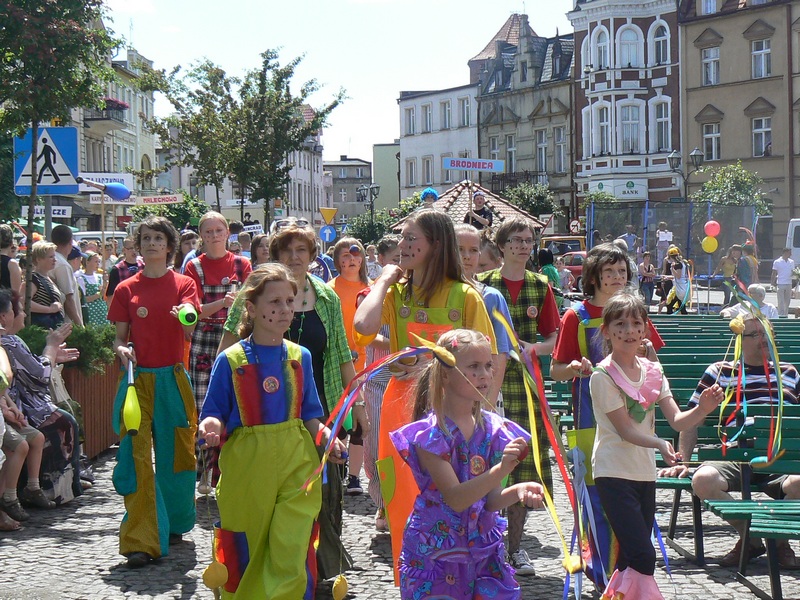Brodnica
Brodnica – in here the main square has a shape of a triangle!
| History of | City Tour | Photo Gallery |
History of Brodnica
This 28 thousand stronghold town is situated on the Drwęca river bank. It was given the municipal rights in 1298, from the Order of the Teutonic Knights. The town belonged to the Order from the mid 13th century to the year 1479. This is because one of the Polish princes that reigned in Kujawy sold the lands to the Teutonic Knights. The land was called Michałowska (after the present day district of Brodnica, Michałowo). During the war 1454 – 1466, Brodnica at times belonged to the kingdom of Poland, and at times to the Teutonic Knights Order. The town saw its prime in the 14th century. Another period of its fast development was 1604-1625, when it was governed by princess Anna Vasa, the sister of the Polish King Sigismond the 3rd. After that, the town was ruined during the wars with Sweden. In 1772 Poland was partitioned by the neighbouring countries and Brodnica became part of Prussia. In the years 1807-1815 it belonged to the Duchy of Warsaw, a Polish state created by Napoleon. In 1831 a Polish uprising was crushed and the dwellers of Brodnica could see the Polish troops, captured by the Prussians, march through their town. Brodnica returned to Poland in 1920. |  |  |
City Tour Brodnica
Let’s start its sightseeing from the unique market square. Contrary to the name, it is shaped in a triangle. In the middle of it, we can see the remains of the former Gothic Town Hall, built in the end of the 14th century. What is left is a tall octagonal tower with a clock and the northern wall. Around it there are tenement houses, built in later centuries. Walking down the Farna Street, we will get to the St Catherine parish church, the construction of which started in 1285. This brick church was built in the Gothic style. It is oriented, which means that its chancel is oriented to the East, together with its main altar, built in the baroque style. It is an example of a hall church, with the nave and the two aisles equal in height. The interior of the church is covered with Gothic, renaissance and baroque polychrome (wall paintings). There are also Gothic sculptures and a figure of Christ on the cross from the second half of the 14th century. Do not miss a rarity: the coffin portraits of the House of theTrzcińscy.
 |  |  |
Between the bridge and the tower there is the Tylna Street. We turn right into it and get to the św. Jakuba Street, with a renaissance (1604) brick granary on its left corner. There you can see the collection of the Museum of Brodnica with its exposition, presenting everyday life of hunters 10000 years ago. This exposition includes the artefacts of the archaeological excavations that took place in Mszana upon Drwęca, in a hunters settlement. From the św. Jakuba Street we will turn right into the Przedzamcze Street that leads to the Small Square.
On its corner we can see the brick Chełmińska Gate, built in the years 1310-1330, the only preserved gate in the town. The interior of the gate is used by the Brodnica Museum. Passing the gate, we enter the Kamionka Street, which leads us to Chopin’s Park, stretching on the left side of the Street. In this park we can admire interesting plant species with such rarities as a hybrid plane, a tree with characteristically exfoliating bark. We leave the park thoughout the gate in the defensive wall that encircled the town in the 14th century. We proceed to the palace of princess Anna Vasa (Polish: Wazówna), built in the second half of the 16th century and rebuilt in the renaissance style by the princess. In front of it there is Anna Vasa’s statue.
 |  |  |
We turn left into Zamkowa Street, which leads us to the Sądowa Street. There we turn left. We pass the coach station and the junction with the Sienkiewicza Street. On the left side of the Sądowa Street there is an old graveyard with interesting headstones. Behind it we can see the church and monastery of Reformers, presently Franciscans. This baroque complex was founded in the years 1751-1761. After the suppression of the order in 1868, the church was transformed into a graveyard church and later into a garrison church. The monastery, in turn, was used as a jail in the years 1839-1945. In the basement of the monastery, crypts can be visited, with mummified bodies of the monks. The walls of the church are covered with numerous decorative plaques.
Kategoria:
Angielski
Tytuł:
Brodnica


